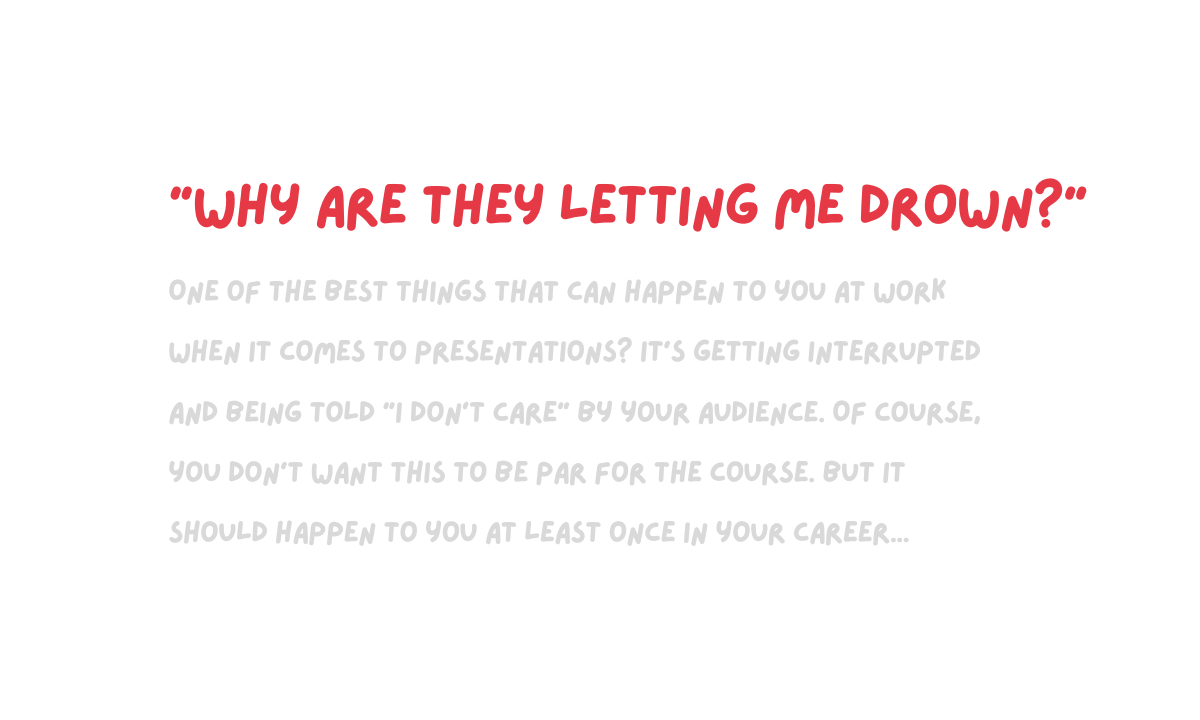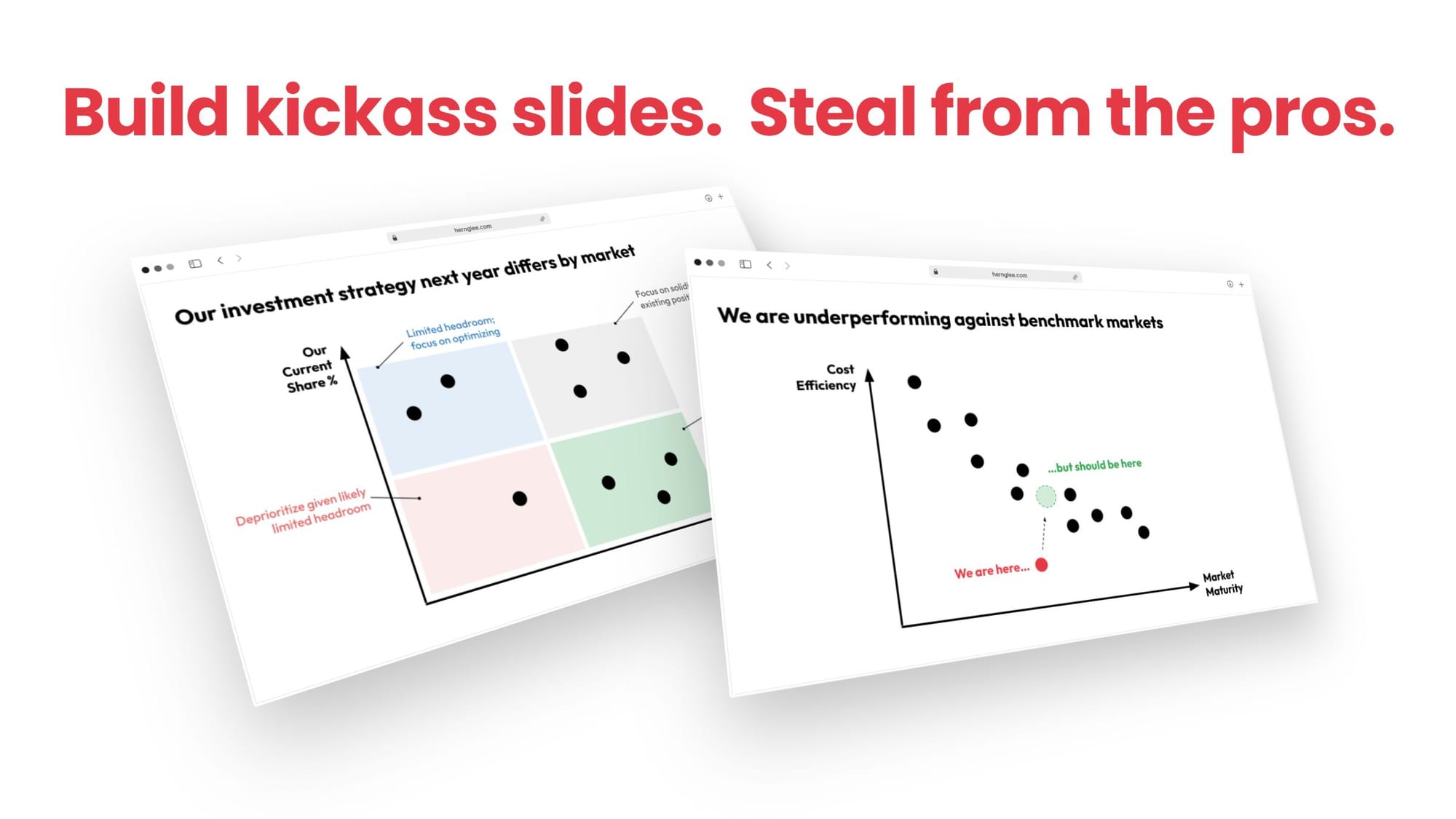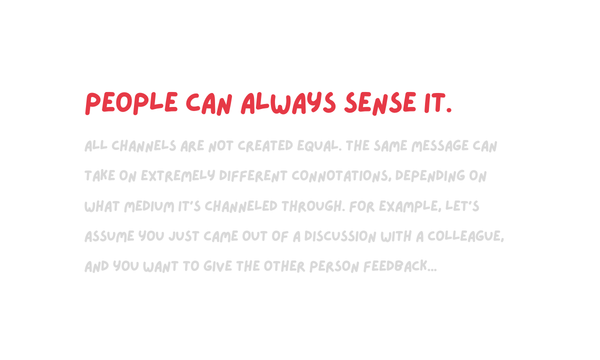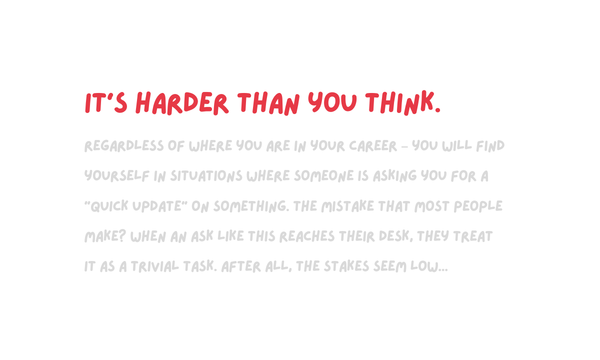Everyone should be told "I don't care" at least once

One of the best things that can happen to you at work when it comes to delivering presentations?
It's getting interrupted and being told "I don't care" by your audience.
Of course, you don't want this to be par for the course. But it should happen to you at least once in your career.
Why? Because most people never experience it. The audience they present to are usually too nice to ever say it to their faces.
As a result: when we communicate ineffectively – nobody stops us. No one calls us out. Nobody helps us course-correct.
More often than not, they let us carry on. We simply waste time and lose credibility.
And worst of all? We never realize why. We then end up making the same mistake, over and over again.
In fact, let me revise what I said earlier: getting told "I don't care" in the middle of the presentation is only the second best thing that can happen to you.
Getting told "I don't care, and the reason is..." is even better.
Because again – even if we sense disengagement or dissatisfaction from our audience – we often don't know why.
And if people aren't being charitable enough to tell us explicitly that we're not "hitting the spot?" They usually aren't going the extra mile and explaining to us why.
We're lucky if someone actually cuts us off and gives us a reason. Otherwise we keep drowning.
For me personally? The few times that I've had the privilege of being told "I don't care" or "OK I get it, skip" to my face have been both embarrassing yet life-changing.
Because it was only then that I started thinking:
"How many other meetings have I been in where people were too nice to say it, but thinking it in their heads?!"
And only then did I realize: while there are only a few ways to make people care – there are a ton of other ways to lose your audience.
So consider today's newsletter a checklist – as I'll share some of the most common ways in which I see people "losing their audience" without realizing it.
And the next time you present: you can then be sure that your audience isn't simply nodding along while thinking "I don't care" in their heads.
Let's dive in.
👋 Join 5000+ readers and subscribe to Herng's Newsletter for free:
#1 "I don't care...because it's not within my scope."
Here's a fact: most people barely have enough mindspace to handle their core remit.
So even if you're talking about stuff that is interesting, important, or even insightful?
If it doesn't fall within your audience's remit, they tend to not really care. And if you drag on for too long – you'll lose them.
For example, imagine that you've just analyzed user feedback for your company's product, and you've concluded that there are 3 things to fix:
- Users feel that they are seeing too many ads.
- Users are unhappy with recent price hikes.
- Users find your product slow and buggy.
A common mistake? Taking all these insights and delivering them the same way, regardless of your counterpart.
Because:
- If you're meeting a Product Manager in charge of monetisation? Focus on #1 (ad load). Don't waste time talking about product speed.
- Similarly, if you're meeting a Finance Director? Get straight to the point and talk about #2 (pricing). Maybe #1 (ad load) too as it may be relevant. Don't waste time on #3. It may be important – but they just don't care.
Remember: more isn't better. Different people care about different things. The more distractions there are, the less attention we'll get.
⭐ Want access to my favorite slide templates, cheat sheets, and storytelling techniques? It's all here — and it's 100% free.
#2 "I don't care...because I get it already."
Context-setting is critical when it comes to presentations.
But what many people forget is that not everyone needs that context.
So if you simply use the same material over and over again, regardless of your audience? You increase the risk of losing your audience's attention.
Here are a few examples (all adapted from real-life examples I've seen):
- Presenting to a senior leader, and spending the first 5 minutes to establish market insights of a given country... not recognizing that the leader is literally the country head and already well aware.
- Asking for exec support on a workstream, and focusing on selling the potential upside... not realizing that no one is questioning it (and instead, people are focused on other things like costs).
- Asking people to adopt a new process, and explaining in detail why it is good for the business... not realizing that of course they know it's good for the business – there are just other reasons why they find the new process cumbersome.
In each of these cases, it's not that what you're communicating is unimportant. It just simply doesn't need to be established with that particular audience, or in that particular context.
And if you're not intentional about tailoring to your audience – you end up wasting precious time on both sides. Not to mention the opportunity cost of using that time to land messages that actually matter.
One question I get a lot, however, is this:
"What if I don't know whether they need this context?"
Great question. My answer? Just ask!
For some reason, most people see "asking" as a sign of weakness, as if it'll make them look less confident or less prepared. They feel obligated to simply "power through" their agenda to appear in control.
In reality, this couldn't be further from the truth.
Because while the best presenters are confident and well-prepared? It is precisely that confidence which enables them to ask things like:
"Would it be helpful to spend 5 min on context, or do you have enough color already?"
"Here is our agenda for today, but is there a section you'd prefer we jump to directly?"
When they ask these questions? It doesn't make them look bad.
The presenter gets useful feedback. The audience is also reassured. It's a win-win for everyone in the room.
So when in doubt:
- Use your best judgment to determine what context is relevant.
- Prepare accordingly. Over-prepare if the stakes are high.
- When you actually present? Just ask. It can only help.
👋 Subscribe for free to get Herng's newsletter directly in your inbox.
#3a "I don't care... just tell me the WHAT."
When people present their own work, they tend to make the mistake of focusing disproportionately on their own tactical efforts (related read: stop telling people to look at your blisters).
After all, it's what they know by heart, and where they spent the most time.
But oftentimes, the person on the other side (especially if they're senior) doesn't care about tactical details. The "how" is relevant, but not important for them.
What they want, instead, is for you to talk about outcomes, implications, or impact. They want the "what."
As an example: imagine you're giving a senior leader a quick update on how a recent analytics project went.
Consider this spiel...
❌ "This project went great! We started by unifying 5 different data streams, and experimented with a few different dashboard layouts before settling on the official one. We then collected user feedback across several teams, which led us to improve the visualizations. We also did this other thing..."
...compared to this:
✅ "The project went great! We ended up saving 100 man-hours weekly for our org, and our users have uncovered $1~2M already in revenue opportunities thus far. We hope to scale this to other orgs by end of year to double the impact."
In general – the more senior your audience is, the more they'll want to focus on "what." Make sure you quench that thirst – or they simply won't care.
Except...
#3b "I don't care... just tell me the HOW."
Ah, but if only life were so simple.
Because in certain instances, you actually want to talk about the "how," as that is what your audience cares about. Only talking about the "what" in this case would be misguided.
For example:
- You're in a knowledge-sharing session, and trying to help scale your best practices to other teams. Actionability and specificity become key.
- You're trying to help your manager become a better advocate for you. Besides communicating the impact you delivered, you want to also establish what exactly you did to get there.
- You're proposing a joint partnership with another team; in addition to selling them on outcomes, you need to be specific about what exactly you need from them, so they can feel comfortable committing.
In fact, one of the most common instances where I see people neglecting to talk about the "how," when they absolutely should?
It's when they're building and communicating strategic plans.
The reason? It's simple. Most people struggle to find the balance between specificity and digestibility. As a result, they bias towards the latter.
They assume that strategic = high level = less detail = no tactics.
They then end up with fluff. And their audience can't find a reason to care.
Side note: want to avoid this mistake? These two essays I wrote can help: Why "be more strategic" is useless advice | The Goldilocks principle of writing strategic plans)
#4 "I don't care... because you're burying the lede."
Sometimes, it's not because your content is irrelevant. And it's not because your narrative doesn't make sense.
It's simply because it's in the wrong order. Which means you're taking too long to "get there."
Because what most people do is this: they tell their stories "chronologically." They set context, explain what they tried to do, share what they found in the process... and only 17 slides later do they arrive at the conclusion.
While it may feel logical to tell your story chronologically? Don't do it. You'll lose your audience way before you get to the meaty stuff.
In fact, when you take the scenic route as a presenter? Your audience is screaming "just get to the point!" in their heads. That's not fair to all your hard work. But neither is it fair to them and their precious time.
Instead, lead with the beef. Get to the point right away. Structure your presentation flow so that you always do some variation of the following:
- Lead with your conclusion or ask first
- Give an overview of supporting arguments
- Surface the evidence that backs up these claims
Remember: it doesn't matter how good your content is. Attention is earned, not given. The onus is always on you to help people care.
#5 "I don't care... because it doesn't move the needle."
There's a blindspot that tends to occur when we become too engrossed in our own work – and forget to consider its perceived importance (or lack thereof) by others.
Put simply? If what you're talking about seems too "small" to matter for your audience – they won't care.
Here are some common examples:
- You're presenting your annual strategy to a leader – yet your portfolio makes up less than 5% of revenue for that leader.
- You're presenting a proposal to improve travel expense tracking for a leader, whose business is facing a 30% gap vs. sales quota.
- You're pitching a cross-functional team on a collaboration idea that will contribute to both team's objectives, but the impact won't materialize anytime soon.
In all these examples, it's not that your message isn't good or important. It's just that for your audience, what you're pitching is too small, too tangential, or too far away to matter.
No wonder they don't care.
Is this fair to us? Not really. But is it justified? Absolutely. It's just a reality we have to accept.
Given we are all the respective centers of our own universes, it becomes even more critical for us to take a hard look at how our message might be perceived before we enter a meeting room.
(Only then can you put your ego aside, and start strategizing alternative ways of making people care. For example, consider applying my favorite contextualization techniques when it comes to storytelling.)
Quick Summary
Let's recap. Whenever you're about to present something, put your ego aside first, and ask yourself if your audience might be thinking:
- "I don't care... because it's not within my scope."
- "I don't care...because I get it already."
- "I don't care... just tell me the WHAT."
- "I don't care... just tell me the HOW."
- "I don't care... because you're burying the lede."
- "I don't care... because it doesn't move the needle."
Related Materials
It can be frustrating when you've put significant effort behind a presentation, only for it to be met by apathy from your audience.
It can be even more frustrating when they're supposed to care but don't – as a result of poor structure, confusing storylines, or misleading signals.
Thankfully, this need not be the case. The ball is in our court. Here are some more materials to help uplevel your comms toolkit:
- How to build "exec-ready" slides (50-page playbook)
- How to write in a "polished" manner at work
- What leaders expect when they read your work



